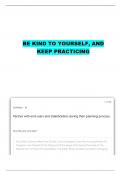Table of content
Lecture 3 – Memory...............................................................................................................................1
Working memory................................................................................................................................1
Long term memory.............................................................................................................................4
Clinical relevance................................................................................................................................6
Societal relevance...............................................................................................................................6
3. Memory..............................................................................................................................................6
Baddeley et al. From short-term store to multicomponent working memory: The role of the modal
model.................................................................................................................................................6
Context Memory in Korsakoff’s Syndrome.........................................................................................9
Lecture 3 – Memory
Working memory
Memory has multiple steps
,20-09-2021 2
Memory is the ability to store information, to retain it and apply it later, in both recognition and reproduction.
Studying new material requires your working memory.
HM patient had bilateral hippocampal surgery. There was long term memory impairment, but an intact working
memory. This shows us that long term memory and working memory are processes in different brain regions.
Working memory theory: there is succession of storage systems. There is information flow/
Atkinson and Shiffrin
Short term storage is a working memory. It controls the flow of information into and out of long term memory.
Problems with this model:
Maintenance guarantees long term storage. Learning depends on nature of processing.
Serial process not valid in impaired patients. Long term memory does not solely depend on short term
memory
Baddeley and Hitch introduced attentional control with dual pathways with limited capacity.
There is one central executive with the visuo-spatial sketch path (visual) and the phonological loop (auditory)
Differences between these two models:
Atkinson says there is an unitary system vs. Baddeley says there are 3 interacting subsystems
Atkinson says there are successive stages vs. Baddeley says there is parallel processing
Explains for dissociations found in patients
Baddeley has updated his model
, 20-09-2021 3
You need a episodic to retrieve information from the long term memory and to store new information.
An important aspect of this model is the dissociation from the sensory processes.
There are 5 experiments to assess working memory:
Free recall word list
Peterson procedure
Proactive interference
Recognition with probe
Missing scan
The right hemisphere is more active in a spatial task. The left hemisphere is more active in a verbal task.
This shows there is dissociation between content of the material.
Dual task paradigm
You had to memorise the location or the duration. The question will be: was the star above the plus (spatial) or
was the star longer in duration (temporal).
Results: there is a dissociation between space and time. Spatial information is only affected by spatial
interference and temporal information only by temporal interference.
Baddeley (update)
Addition to episodic buffer: Combination of senses: vision, audition, perhaps also smell and taste.
There is temporary store and limited capacity.
Phonological loop: there are speechlike memory traces (2s). There is a phonological similarity effect. It is easier
to distinguish words that differ.
Forgetting
Forgetting is not the same as impairment, it is a natural process.
Childhood amnesia refers to the fact that up until 4/5 years old, you don’t have any memories. You make room
for new memories.
Reflects decay of memorized information over time.
Rapid forgetting is normal and common. It refers to loss of information within seconds. This increases with age.
If you have it excessively, it could be a marker of Alzheimer’s.
The mechanism behind this is unclear.











